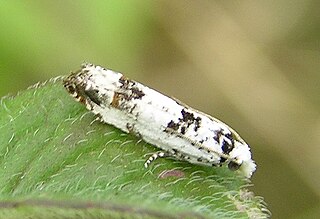
Eucosma campoliliana is a moth of the family Tortricidae. It is found in Europe, China, Japan and Russia.
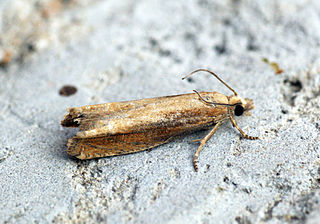
Eucosma obumbratana is a moth of the family Tortricidae. It is found in Europe, China (Jilin), Russia and Kazakhstan.

Eucosma conterminana, the lettuce tortricid, is a moth of the family Tortricidae.

Eucosma cocana, the shortleaf pinecone borer moth, is a species of moth of the family Tortricidae. It is found in south-eastern North America and along the eastern seaboard.
Eucosma lugubrana is a species of moth of the family Tortricidae. It is found on Sicily and in France, Austria, Italy, Slovakia, Hungary, North Macedonia, Greece and Russia, Kazakhstan and Kyrgyzstan.

Eucosma metzneriana, the mugwort bell, is a species of moth of the family Tortricidae. It is found on Sicily and in Great Britain, the Netherlands, Belgium, Luxembourg, France, Germany, Denmark, Austria, Switzerland, Italy, the Czech Republic, Slovakia, Slovenia, Hungary, Bulgaria, Romania, Poland, Sweden, Finland, the Baltic region, Ukraine, Russia, North Africa, Transcaucasia, Asia Minor, Iran, Kazakhstan, Kyrgyzstan, Mongolia, China, Korea and Japan.

Eucosma pupillana is a species of moth of the family Tortricidae.
Eucosma abacana is a species of moth of the family Tortricidae. It is found in China, Mongolia, Japan, Russia and Kazakhstan.
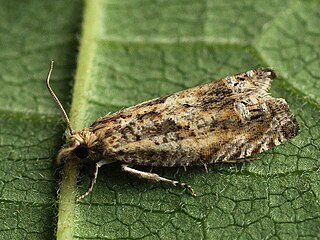
Eucosma aemulana, the obscure bell, is a species of moth of the family Tortricidae. It is found in China, Korea, Russia and most of Europe. It is also found in the United States, where it has been recorded from Colorado, New Mexico, Oklahoma and Utah. The habitat consists of woodlands, chalk downland and cliffs.

Eucosma agnatana is a species of moth of the family Tortricidae. It is found in China, Mongolia, Russia, Kazakhstan, Romania, Russia and the Near East.

Eucosma aspidiscana, the golden-rod bell, is a species of moth of the family Tortricidae. It is found in China, Mongolia, Korea, Japan, Russia, North Africa and most of Europe. The habitat consists of woodlands, downland, waste grounds and cliffs.

Eucosma cana, the hoary bell, is a species of moth of the family Tortricidae.

Eucosma explicatana is a species of moth of the family Tortricidae. It is found in China, Mongolia, Russia and Kazakhstan.
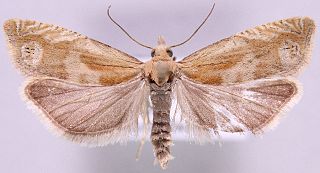
Eucosma hohenwartiana, the bright bell, is a species of moth of the family Tortricidae. It is found in China, Central Asia, North Africa and Europe, where it has been recorded from Sardinia, Sicily, Ireland, Great Britain, Spain, France, Germany, the Benelux, Denmark, Austria, Switzerland, Italy, the Czech Republic, Slovakia, Slovenia, Hungary, Poland, Romania, Bosnia and Herzegovina, Norway, Sweden, Finland, the Baltic region and Russia. The habitat consists of dry open areas and grassland.

Eucosma messingiana is a species of moth of the family Tortricidae. It is found in China, Mongolia, Russia and Europe, where it has been recorded from Germany, the Czech Republic, Denmark, Hungary, Poland, the Baltic region, Sweden and Finland. The habitat consists of sandy areas.
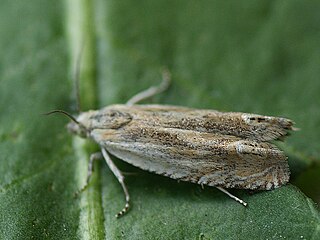
Eucosma wimmerana is a species of moth of the family Tortricidae. It is found in China, Mongolia, Japan, Russia, Kazakhstan and Europe, where it has been recorded from Sicily, France, the Netherlands, Germany, Austria, Switzerland, Italy, the Czech Republic, Slovakia, Poland, the Baltic region, Slovenia and Romania.
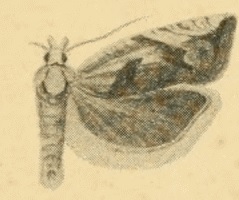
Eucosma tundrana is a species of moth of the family Tortricidae. It is found in China, Russia, Kazakhstan and Europe, where it has been recorded from Germany, the Czech Republic, Slovakia, Hungary and Romania.

Eucosma scorzonerana is a species of moth of the family Tortricidae. It is found in China, Russia and Kazakhstan and Europe, where it has been recorded from Italy, the Czech Republic, Slovakia, Norway, Sweden, Finland, Estonia, and Latvia.

Eucosma dorsisignatana, the triangle-backed eucosma, is a species of moth of the family Tortricidae. It is found in North America, where it has been recorded from Nova Scotia to Florida, west to Texas and north to Manitoba.

Eucosma giganteana, the giant eucosma moth, is a species of moth of the family Tortricidae. It is found in the United States, where it has been recorded from North Carolina to Florida, Minnesota to Texas, as well as in Pennsylvania, North Dakota and New Mexico.



















